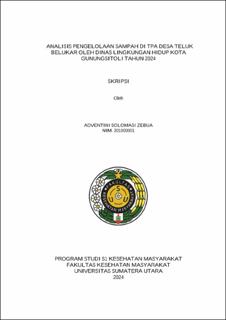| dc.description.abstract | Waste is still an environmental problem that has not been handled properly until now. Improper waste management can have a negative impact on the environment and humans. In 2023, Gunungsitoli City will generate 44,855 tons of waste, of which 23,879 tons of waste ends up in the Teluk Belukar Village Landfill. The purpose of this study is to analyze the input components, process components, output components, obstacles, and public perception of waste management in the Teluk Belukar Village Landfill by the Gunungsitoli City Environmental Agency. This type of research is qualitative research with a case study design. The data collection used was observation, in-depth interviews, and documentation. The data was analyzed descriptively to be able to provide an overview of waste management carried out by the Gunungsitoli City Environmental Agency. The results of this study show that the input and process components still do not meet the applicable regulations, causing obstacles in waste management carried out by the Gunungsitoli City Environmental Agency. In the output component, the leachate control carried out is safe for the environment, but recycling activities in the form of composting can only process 50 kg of waste per month so that the composting activities carried out are not optimal. The community around the Teluk Belukar Village Landfill also felt uncomfortable and disturbed by the waste management carried out. This shows that the management of waste management at the Teluk Belukar Village Landfill by the Gunungsitoli City Environmental Agency is still not optimal. It is recommended to the Gunungsitoli City Environmental Agency to improve the waste management system at the Teluk Belukar Village Landfill in accordance with the regulations that have been set | en_US |


